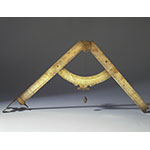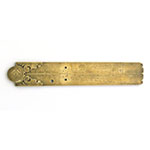One of the many compasses built by Galileo starting in 1597. Possibly the model presented by Galileo to Cosimo II together with a copy of Le operazioni del compasso geometrico et militare [Operations of the geometric and military compass] (Padua, 1606). The Galilean compass—not to be confused with drawing compasses—is a sophisticated and versatile calculating instrument for performing a wide variety of geometrical and arithmetical operations, making use of the proportionality between the corresponding sides of two similar triangles. It comprises three parts:
- the two legs, held together by a round disk (pivot), whose faces (front and back) are engraved with numerous scales;
- the quadrant, graduated with various scales, which is fixed by means of wing nuts to the holes in the compass legs;
- the clamp, a cursor inserted into one of the compass legs; keeps the instrument vertical and can serve as an extension for the leg holding it.
The priority for the instrument's invention was claimed by the Milanese Baldassarre Capra in a work published in Padua in 1607. Galileo replied effectively to Capra's claims with a peremptory Difesa [Defense].
The compass, initially kept in the Uffizi Gallery, was transferred in the mid-nineteenth century to the Tribuna di Galileo.











